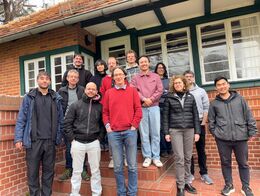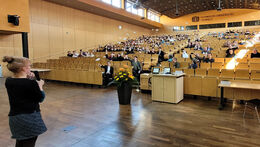Welcome to the collaborative Research Center TRR 181 ”Energy transfers in Atmosphere and Ocean“
The seamless integration of large data sets into sophisticated computational models provides one of the central research challenges for the mathematical sciences in the 21st century. When the computational model is based on evolutionary equations and the data set is time-ordered, the process of combining models and data is called data assimilation. The assimilation of data into computational models serves a wide spectrum of purposes ranging from model calibration and model comparison all the way to the validation of novel model design principles.
The field of data assimilation has been largely driven by practitioners from meteorology, hydrology and oil reservoir exploration; but a theoretical foundation of the field is largely missing. Furthermore, many new applications are emerging from, for example, biology, medicine, and the neurosciences, which require novel data assimilation techniques. The goal of the proposed CRC is therefore twofold: First, to develop principled methodologies for data assimilation and, second, to demonstrate computational effectiveness and robustness through their implementation for established and novel data assimilation application areas.
While most current data assimilation algorithms are derived and analyzed from a Bayesian perspective, the CRC will view data assimilation from a general statistical inference perspective. Major challenges arise from the high-dimensionality of the inference problems, nonlinearity of the models and/or non-Gaussian statistics. Targeted application areas include the geoscience as well as emerging fields for data assimilation such as biophysics and cognitive neuroscience.
Speaker
Prof. Dr. Melina Freitag, University of Potsdam, Institute of Mathematics
Managing Director
Dr. Lydia Stolpmann, University of Potsdam, Institute of Mathematics
News
Focus Retreat on Hiddensee 2025

The 4th Focus Retreat on Hiddensee took place from April 11th to 15th, 2025. The research groups of Sebastian Reich (UP), Wilhelm Stannat (TU Berlin),… more ›
Melina Freitag was invited speaker at the 7th Day of Mathematics at the TU Chemnitz

Melina Freitag was invited speaker at the 7th Day of Mathematics at the TU Chemnitz. As part of her keynote speech on "Looking into the Future with… more ›
AI-supported analysis, modeling and synthesis of organoids

This month, a new project on organoids kicks-off. The project is funded by the Carl Zeiss Foundation and will investigate the precise description of… more ›
Upcoming Events
Comparing Neural Representations
Heiko Schütt, University of Luxembourg 2.28.0.10810:15 - 11:45
In computational neuroscience and machine learning, we develop more and more complex deep neural network models to mimic the human brain and to solve…
more ›IRTG Workshop: Career Planning, Profile Development, and Self-Presentation for female Researchers I
Pd Dr Mareike Menne, BUSCH & DR MENNE Hochschulconsulting 09:00-13:00
Online Workshop with PD Dr Mareike Menne
In the first part of the workshop, we will cover key principles of career planning, labour market…
IRTG Workshop: Career planning, profile development, and self-presentation for female Researchers II
PD Dr Mareike Menne, BUSCH & DR MENNE Hochschulconsulting 09:00 - 13:00
Online Workshop with PD Dr Mareike Menne
In the second part, we will build on this initial work. Often, concrete questions arise at this stage, such…
more ›Latest Publications
Kim, J. W. and Reich, S. (2025): On forward-backward SDE approaches to continuous-time minimum variance estimation. In: Chapron, B., Crisan, D., Holm, D., Mémin, E., Coughlan, J.-L. (eds) Stochastic Transport in Upper Ocean Dynamics III. STUOD 2023. Mathematics of Planet Earth, vol 13. Springer, Cham., pp. 115-136. doi: 10.1007/978-3-031-70660-8
Reich, S. (2025): A particle-based Algorithm for Stochastic Optimal Control. In: Chapron, B., Crisan, D., Holm, D., Mémin, E., Coughlan, J.-L. (eds) Stochastic Transport in Upper Ocean Dynamics III. STUOD 2023. Mathematics of Planet Earth, vol 13. Springer, Cham., pp. 243-268. doi: 10.1007/978-3-031-70660-8
Pidstrigach, J., Marzouk, Y., Reich, S., and Wang, S. (2024). Infinite-Dimensional Diffusion Models. JMLR,Vol. 25, 1-52, arXiv 2302.10130










